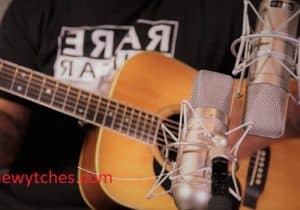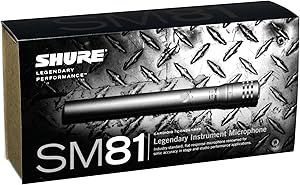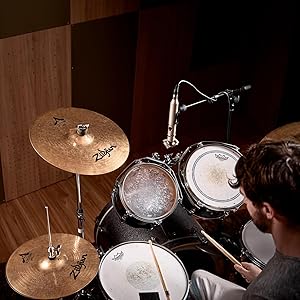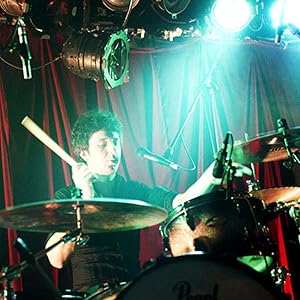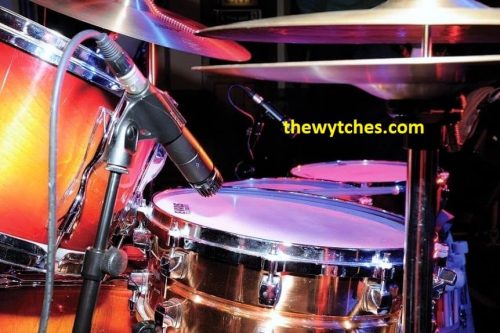The ideal microphone for acoustic guitar enhances the singing experience by harmonizing with the instrument’s sound. Hello friends, this article will discuss the finest mic for acoustic guitar recordings and live performances. Guitars are easy to play, but recording them in a studio is another matter. Acoustic guitars are hard to capture in studios with the same tone and sounds as when performing.
For guitar recording in the studio, you need decent mics. We have the top 7 coolest acoustic guitar mics. Try our checklist. We’ve included our top 7 guitar mics here. We’ve also included Amazon links so you can check the current price and more customer reviews. If you don’t want to read the full article, scroll down:
Contents
- 1 7 Best Mic for Acoustic Guitar Recording
- 1.1 1-Shure SM81-LC Cardioid Condenser Instrument Microphone.
- 1.2 2-AKG Understanding 170 Expert Instrument Microphone.
- 1.3 3-Rode NT 2A Wedding Anniversary Microphones.
- 1.4 4-Shure SM-57 Cardioid Microphone.
- 1.5 5-Rode NT4 X/Y Condenser Microphone.
- 1.6 6-MXL 770 Condenser Microphone.
- 1.7 7- Rode NT5 – Matched Pair, Silver
- 2 Conclusion
- 3 FAQs:
7 Best Mic for Acoustic Guitar Recording
1-Shure SM81-LC Cardioid Condenser Instrument Microphone.
The Shure SM81-LC is a professional-grade condenser microphone designed for capturing acoustic instruments with precision. Its flat frequency response ensures natural sound reproduction, making it excellent for guitars, pianos, and cymbals. The cardioid pickup pattern reduces background noise while focusing on the source, ideal for both studio and live use. Built with Shure’s legendary durability, it features an attenuator switch lock and windscreen for added versatility. Though it doesn’t include a cable, its reliability and consistent performance make it a top choice for serious musicians and recording engineers.
Specifications:
- Type: Condenser cardioid
- Frequency response: 20 Hz – 20 kHz
- Includes swivel adapter, windscreen, and carrying case
- Requires phantom power
Pros:
- Industry-standard for acoustic instruments
- Flat frequency response for natural sound reproduction
- Extremely durable and reliable for live or studio use
Cons:
-
Higher price point compared to entry-level options
2-AKG Understanding 170 Expert Instrument Microphone.
The AKG Perception 170 is a small-diaphragm condenser microphone crafted for professional instrument recording. With its cardioid pickup pattern, it isolates the sound source effectively while minimizing room noise. Compact and lightweight, it’s perfect for acoustic guitars, drum overheads, and string instruments. The rugged build quality ensures long-lasting performance, and its 20 dB pad switch allows it to handle high sound pressure levels with ease. Musicians and podcasters love it for its affordability without compromising on sound quality. Overall, the AKG P170 delivers clarity and detail, making it one of the best entry-level condenser mics for studios on a budget.
Specifications:
- Type: Small-diaphragm condenser
- Frequency response: 20 Hz – 20 kHz
- Compact and lightweight design
- Switchable attenuation pad (-20 dB)
Pros:
- Affordable yet professional-quality mic
- Crisp and accurate for acoustic guitars
- Great value for beginners and home studios
Cons:
-
Build quality not as robust as premium mics
3-Rode NT 2A Wedding Anniversary Microphones.
The Rode NT2-A is a versatile large-diaphragm condenser microphone that excels in studio recording. With multiple polar patterns (cardioid, omnidirectional, and figure-8), it adapts to different recording needs, from solo vocals to instrument ensembles. Its wide frequency response and low self-noise deliver pristine, detailed sound that suits singers, voice-over artists, and instrumentalists alike. The NT2-A also comes as part of a complete studio solution kit, including shock mount, pop filter, and cable—ideal for beginners and professionals. Rode’s excellent build quality ensures durability, while its warm and natural sound makes it a favorite for both music production and broadcasting setups.
Specifications:
- Type: Large-diaphragm condenser
- Frequency range: 20 Hz – 20 kHz
- Three polar patterns (cardioid, figure-8, omnidirectional)
- Includes shock mount, pop filter, and XLR cable
Pros:
- Versatile for instruments, vocals, and acoustic guitar
- Low self-noise ensures clean recordings
- Excellent package with included accessories
Cons:
-
Larger size makes positioning tricky for guitar recording
4-Shure SM-57 Cardioid Microphone.
The Shure SM57 is an industry-standard dynamic microphone known for its reliability and versatility. It is widely used for amplifying guitar cabinets, drums, and brass instruments in both studio and live environments. Its cardioid pickup pattern provides excellent isolation, while the tailored frequency response captures instruments with clarity and punch. The rugged construction ensures it can withstand years of heavy use, making it a go-to for touring musicians and recording engineers. Affordable and dependable, the SM57 remains one of the most trusted microphones worldwide. If you need a durable, professional microphone that performs consistently, the Shure SM57 is hard to beat.
Specifications:
- Type: Dynamic cardioid
- Frequency response: 40 Hz – 15 kHz
- Extremely durable design
- Industry standard for live and studio instruments
Pros:
- Affordable and reliable option
- Handles high sound pressure levels with ease
- Compact and versatile for guitar, amps, and percussion
Cons:
-
Not as detailed as condenser mics
5-Rode NT4 X/Y Condenser Microphone.
The Rode NT4 is a stereo condenser microphone designed for professional-quality sound recording. Featuring an X/Y stereo configuration, it captures natural stereo imaging with incredible detail, perfect for live performances, choirs, acoustic instruments, and ambient field recordings. Its dual cardioid capsules are perfectly matched, ensuring balanced and phase-accurate audio. The NT4 can run on phantom power or a 9V battery, making it versatile for both studio and outdoor use. With its sleek silver design and solid build, it provides long-lasting reliability. Musicians, filmmakers, and sound engineers appreciate its ability to capture immersive stereo sound in a single, easy-to-use setup.
Specifications:
- Type: Stereo condenser (XY configuration)
- Frequency range: 20 Hz – 20 kHz
- Powered by phantom power or a 9V battery
- Includes stereo cable and accessories
Pros:
- Captures rich stereo field for natural acoustic sound
- Easy setup with fixed XY configuration
- Ideal for acoustic ensembles and solo guitarists
Cons:
-
Heavier and bulkier than single mics
6-MXL 770 Condenser Microphone.
The MXL 770 is a budget-friendly condenser microphone with impressive performance for beginners and home studio enthusiasts. Its large diaphragm and cardioid pickup pattern deliver warm vocals and clear instrument recordings while minimizing background noise. Perfect for podcasting, gaming, singing, and streaming, the 770 provides studio-quality sound without a hefty price tag. It handles both high and low frequencies well, making it versatile for voice and music. With its sleek black finish and rugged design, it not only looks professional but also performs reliably. For content creators and musicians seeking an affordable yet quality microphone, the MXL 770 is a smart investment.
Specifications:
- Type: Large-diaphragm condenser
- Frequency response: 30 Hz – 20 kHz
- Low-frequency roll-off and -10 dB pad switch
- Cardioid polar pattern
Pros:
- Affordable large-diaphragm option
- Warm sound with good clarity for guitars and vocals
- Excellent entry-level mic for home studios
Cons:
-
Build quality is mid-range, not premium
7- Rode NT5 – Matched Pair, Silver
The Rode NT5 matched pair is a set of professional small-diaphragm condenser microphones ideal for stereo recording. These precision-matched mics are excellent for capturing acoustic instruments, drum overheads, and live performances with accurate detail and balance. The cardioid polar pattern ensures focused sound capture, reducing unwanted noise from the sides and rear. Rode’s high-quality engineering provides low self-noise and crystal-clear audio, making them suitable for both professional studios and field recordings. Their compact silver design is both elegant and durable. For producers and engineers needing reliable stereo sound with depth and clarity, the Rode NT5 matched pair is an outstanding choice.
Specifications:
- Type: Small-diaphragm condenser (matched pair)
- Frequency range: 20 Hz – 20 kHz
- Cardioid polar pattern
- Includes stand mounts and windshields
Pros:
- Perfect for stereo recording of acoustic guitar
- High clarity and detail in the upper range
- Professional quality at a reasonable price
Cons:
-
Requires careful mic placement for best results
Conclusion
Finally, if you have read our little post, it’s time for you to post your thoughts on our attempt to help you choose the best microphone for acoustic guitars. Tell us which one you liked best and why, and let us know in the comments if you think any more excellent microphones should be on our list of the finest for recording guitar. Many of our items are included on the site, thewytches.com.
FAQs:
What features should I look for when choosing the best mic for acoustic guitar recording?
When selecting the best mic for acoustic guitar recording, focus on clarity, frequency response, and pickup pattern. A cardioid condenser mic is often preferred because it captures rich details while minimizing background noise. Look for wide frequency coverage (20Hz–20kHz), low self-noise, and adjustable features like attenuation pads or high-pass filters to handle different playing styles and environments effectively.
Is a condenser or a dynamic microphone better for acoustic guitar recording?
For acoustic guitar recording, condenser microphones are generally the better choice over dynamic mics. Condensers are more sensitive and capture subtle nuances, making them ideal for fingerpicking and strumming details. Dynamic mics, while durable, may lack the tonal richness needed for studio-quality recordings. However, a dynamic mic could still be useful in live settings where feedback resistance is important.
Do I need one or two microphones for the best acoustic guitar recording quality?
The number of microphones you need depends on your recording style and goals. A single high-quality condenser mic can produce excellent results, especially for solo performances. However, using two microphones in stereo can add depth, balance, and a natural soundstage. Techniques like XY or spaced pairs capture both warmth and brightness, giving your recordings a more professional and immersive quality.
See also:
